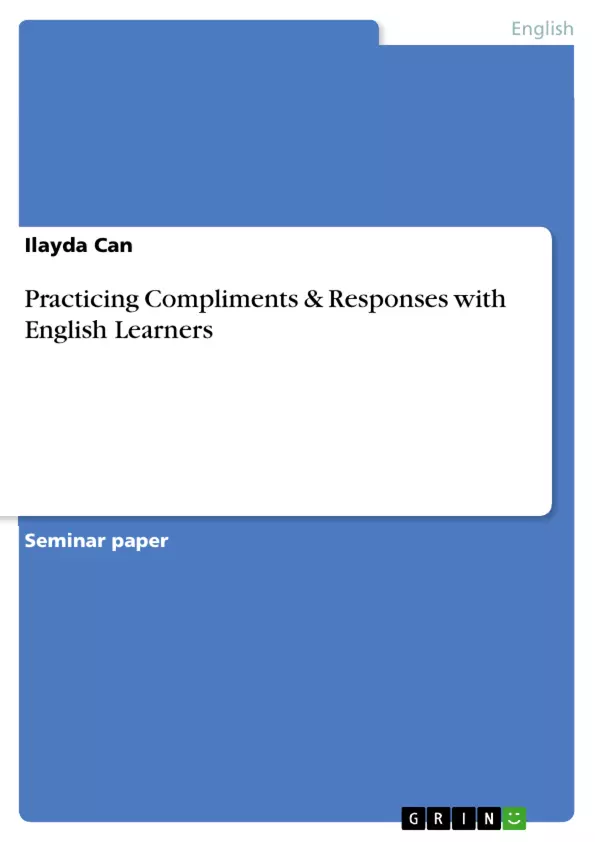When it comes to teaching English in the foreign language classroom, we can build on Ishihara’s statement that interventional studies indicate that pragmatics may be taught and learned. Compliments and responses to compliments are no exception. After the description of the linguistic realization of compliments and responses to compliments, the readers will be provided with a teaching concept consisting of: a lesson plan, an analysis of teaching and learning requirements, an analysis of the subject matter, a didactic and method analysis, which provide pedagogical suggestions and practical tools for teaching English learners in the foreign language classroom (upper secondary education, 11th grade). Subsequently, the most important aspects will be recapitulated in the conclusion. The purpose of this paper is to demonstrate how to practice giving compliments and responding to compliments in English.
Inhaltsverzeichnis (Table of Contents)
- Introduction: Approaching Compliments and Responses
- Theoretical Foundations: The Linguistic Realization of Compliments/Responses to Compliments and a Cross-Cultural Perspective
- Compliments: Syntactic Categories and Word Choice
- Responses to Compliments: Semantic Categories
- Generalizations from a Cross-Cultural Perspective
- Teaching Concept for English Learners in the Foreign Language Classroom
- Lesson Plan
- An Analysis of Teaching and Learning Requirements
- An Analysis of the Subject Matter
- A Didactic Analysis
- An Analysis of the Method
- One-Week-Activity: "Collecting Compliments"
- Conclusion
Zielsetzung und Themenschwerpunkte (Objectives and Key Themes)
This paper aims to demonstrate how to practice giving compliments and responding to compliments in English, providing pedagogical suggestions and practical tools for teaching English learners in the foreign language classroom. The main objective is to present a teaching concept for integrating compliments and responses into an English as a Foreign Language curriculum.
- The linguistic realization of compliments and responses to compliments
- The cross-cultural perspective on compliments and responses
- A lesson plan for teaching compliments and responses to English learners
- An analysis of teaching and learning requirements for this topic
- A didactic analysis of the teaching approach
Zusammenfassung der Kapitel (Chapter Summaries)
The introduction outlines the significance of compliments in conversational interactions, emphasizing their role in building rapport and facilitating social engagement. It explores the various functions of compliments beyond simple expressions of appreciation, highlighting their potential to initiate and sustain conversation, soften face-threatening acts, and even serve as a tool for flirting.
The theoretical foundations chapter delves into the linguistic realization of compliments and responses. It examines the syntactic categories and word choices commonly employed in compliments, citing research by Manes and Wolfson who analyzed thousands of spontaneously occurring compliments in American English. This chapter also explores the semantic categories of responses to compliments, including acceptance, mitigation/deflection, and rejection, with specific examples and subcategories to illustrate each type of response.
The third chapter presents a teaching concept for English learners in the foreign language classroom, offering a detailed lesson plan, an analysis of teaching and learning requirements, a breakdown of the subject matter, and a didactic analysis of the teaching approach. This chapter provides practical tools and pedagogical suggestions for incorporating the practice of compliments and responses into an English curriculum.
Schlüsselwörter (Keywords)
The key themes and concepts explored in this paper include compliments, responses to compliments, pragmatics, cross-cultural communication, teaching English as a Foreign Language (TEFL), lesson planning, didactic analysis, and practical tools for teaching English learners. The research focuses on understanding the linguistic realization of compliments and responses, their various functions in conversation, and effective teaching strategies for incorporating these elements into an English curriculum.
- Quote paper
- Ilayda Can (Author), 2021, Practicing Compliments & Responses with English Learners, Munich, GRIN Verlag, https://www.grin.com/document/1383273



